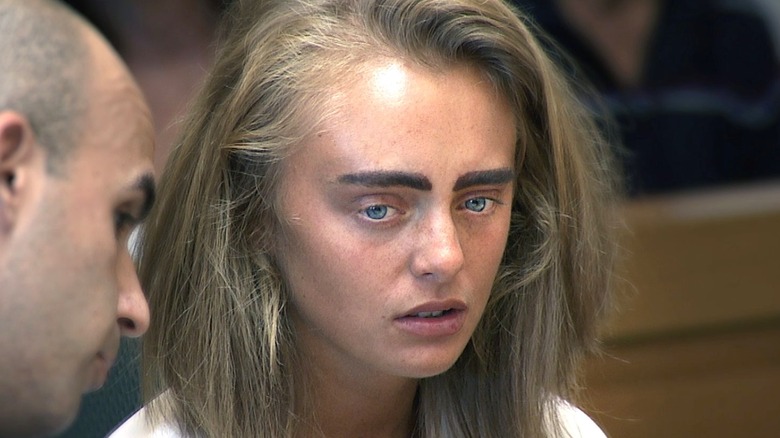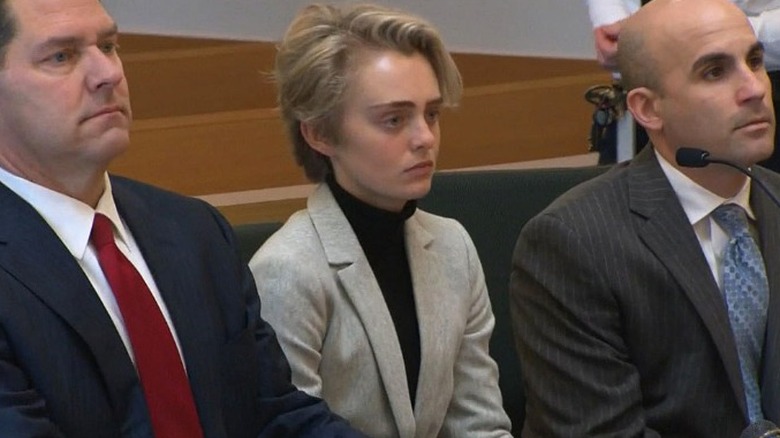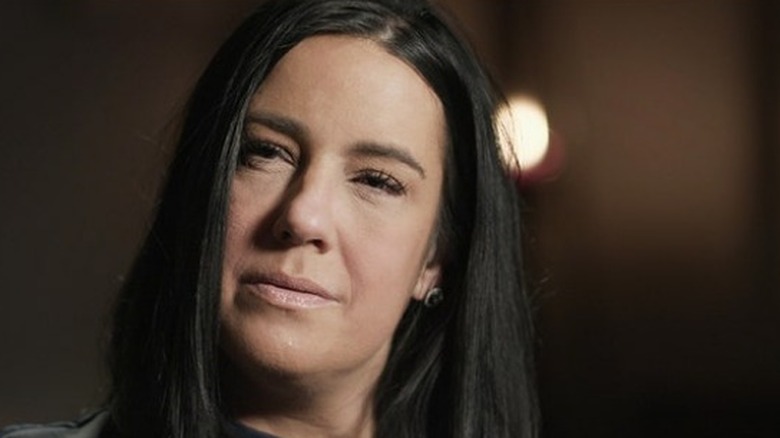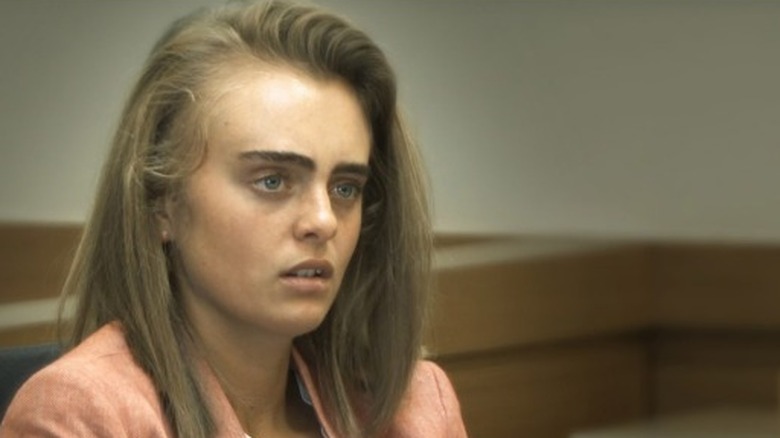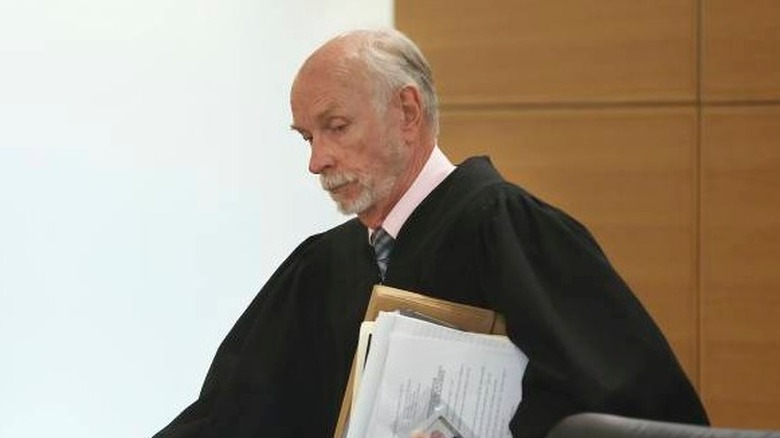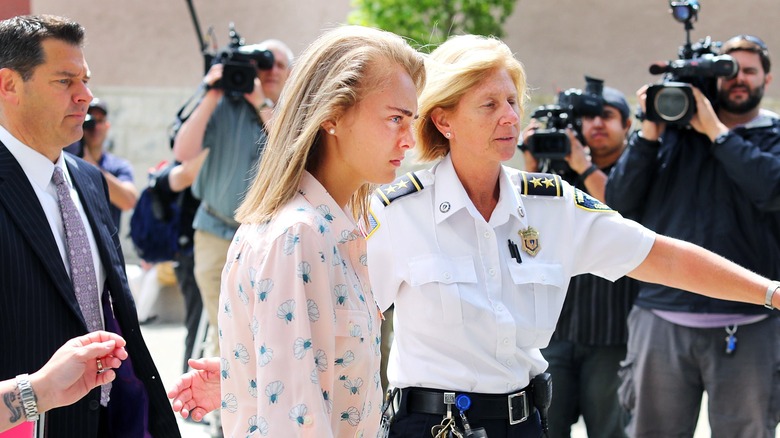How Accurate Is I Love You, Now Die?
Director Erin Lee Carr's HBO documentary about a precedent-setting court case and media fest that took place in Massachusetts in 2017, "I Love You, Now Die: The Commonwealth v. Michelle Carter," sparked numerous conversations about its approach to the story (or, stories) at the heart of the young woman's trial. The tragic events leading up to Carter's prosecution go something like this: in 2014, Carter's boyfriend Conrad Roy III took his own life, allegedly after Carter pressured him into doing so via a barrage of damning text messages (e.g., "You can't think about it," she tells him, "You just have to do it.") Immediately following the discovery of the couple's last text conversation, both the Carter family and those investigating Conrad's death placed the blame squarely on Michelle Carter, who was ultimately charged with (and convicted of, despite there being no legal precedent for such a case in Massachusetts) involuntary manslaughter.
Unlike the onslaught of salacious media stories that surrounded and colored the Michelle Carter case in 2017, Carr's documentary does something The Atlantic's Sophie Gilbert describes as "revolutionary" for the true-crime docuseries genre, in that it "never comes down on one side or offers up a finite conclusion." What the documentary does do, Gilbert suggests, (and with admirable caution and restraint) is "(indict) Carter less than the culture she was raised in." The two-part series does this by first detailing the events leading up-to and surrounding Conrad's suicide, all of which seem to lend credence to the prosecution's case (part 1 is titled, "The Prosecution"), and then, in the second part ("The Defense") Carr explores context and circumstances that give viewers a more complete picture of the pair's mutually destructive dynamic. But just how "accurate" is Carr's nuanced portrayal of the events and the case itself?
Carr gives a balanced depiction of events in "I Love You, Now Die"
If part 1 of "I Love You, Now Die" had viewers applauding the court's controversial decision to hold Carter legally responsible for Roy III's suicide, part 2 had viewers questioning their own willingness to indict the young woman. Esquire Magazine's Jesse Barron explains that the Michelle Carter narrative was "the perfect combination of everything that people hate about teenage girls" (In Barron's words, that people think they're "manipulative" and "crazy," and "only live for attention"). Part 2 delves into the complicated and long-held fear and dislike society has of certain kinds of women — a fear that Massachusetts, home of the Salem Witch Trials, is no stranger to acting upon. At one point, a random local says, "I've never met the girl, but I've seen pictures of her — she just has that look."
Part 2 not only exposes the need that many had for Carter to be as evil as her texts made her appear, it also explores the complicated relationship between the teens. Importantly, the two rarely met in real life, and their relationship took place almost entirely via texts. Over the course of the second half of the series, viewers learn that both Carter and Roy were on anti-depressants that the defense argued both increase suicidal behavior in teens and affect their impulse control and understanding of social situations and the consequences of their actions. Viewers also learn that Roy had attempted suicide on four previous occasions, and that — prior to their dynamic becoming self-reinforcing and toxic for both — Carter had actually told Roy to seek help for his mental state. All of this is supported both by the pair's individual medical histories and the thousands of texts they exchanged well before Roy III's 2014 suicide.
"I Love You, Now Die" sheds light on lesser talked about evidence
Roy's history with suicidal attempts (for which he was hospitalized) directly contradict his parents' repeated claims that they had no idea their son was feeling suicidal at the time of his death. Although "I Love You, Now Die" gives plenty of camera time to both parents, it also attempts to shed some light on the more complicated family dynamics at play that the both the press and the prosecution seemed determined to ignore.
By Lynn Roy's own admission, she noticed her son's behavior changing around the time of his parents' divorce. As Boston.com reports and as the documentary touches on, Conrad's mother Lynn (prior to seeing Carter's final texts to her son) sent the young woman a message saying "I believe some of his Dad & his family members have blood on their hands." The documentary also reveals that Conrad III was physically assaulted by his father, and verbally abused by his father's girlfriend. In a documented statement to the police, Conrad III claimed his father "punched me repeatedly and pinned me down. I couldn't get up. His girlfriend said I was piece of s—."
In "I Love You, Now Die," Conrad II brushes the incident off as just a father disciplining his son. "Things got out of control," he says, but "I'd do it again, just like that."
Carr's documentary explores our ability to treat mental health in teens
None of which is to say that Carr is attempting to indict Roy III's parents for his suicide. If anything, Carr's flushing out of Roy III's volatile family situation and history of suicidal behavior and ideation (particularly with regard to some of the things he texts Carter, including an image of a noose) serves to illustrate a deeper thesis: when it comes to the often fatal consequences of poor mental health, no matter how desperate society may be for someone to blame, there is rarely, if ever, a single culprit. As Esquire's Barron points out at the start of Part 2, both families "want a version of the story in which (Roy III's suicide) is not their fault."
Michelle Carter may indeed have behaved appallingly by failing to see the seriousness of her boyfriend's situation, but Carter herself was also a victim of our inability to fully deal with and adequately treat teenage mental illness. In one of the most revealing scenes, we learn that Michelle's delusional understanding of her relationship with Roy III is actually part of a pattern of behavior. When Barron tracks down a former best friend of Carter's, he learns that the latter's understanding of the pair's relationship as "romantic" was (at least according to the former) entirely in her own head.
Keeping Michelle Carter's own history in mind, the defense argued that at the time Carter sent the series of damning texts to her boyfriend, she was "involuntarily intoxicated" by her medications (she'd switched from Prozac, which she'd been on for three years, after being hospitalized for her mental state and an eating disorder), and therefore could not be held accountable for her actions at the time. But this wasn't always their approach.
"I Love You, Now Die," attempts to explain the legality behind the case and ruling
In a pre-trial hearing, the series explains, the argument was less about Michelle and more about the law. At the time of the trial, Massachusetts had no laws directly or specifically equating verbal coercion via text to involuntary manslaughter. In relaying both defense strategies to viewers, Carr manages to give a far more thorough evaluation of the questions at the heart of the case than most media outlets could do.
Ultimately, Judge Lawrence Moniz found Carter was indeed guilty of the "wanton and reckless behavior" required for an involuntary manslaughter charge, because she encouraged Conrad Roy III to "get back in the truck" when he expressed hesitation. Importantly, as the documentary points out in an interview with defense expert witness Dr. Peter Breggin, there is no text to Roy III verifying that she told him to do this. It's only in Carter's relaying of the exchange to a friend that she claims responsibility. Since "I Love You, Now Die" gives us an image of a mentally ill young woman who frequently lied for attention, Carr seems to be suggesting that Michelle Carter was ultimately found guilty on "evidence" for which there is no proof.
After Moniz' decision was upheld upon appeal, Carter's lawyers took the case to the Supreme Court, arguing this time that the decision "violated her First Amendment right to free speech" (via NBC). The court upheld the verdict. By spending just as much time on the law as she does on Carter and Roy III's relationship in "I Love You, Now Die," Carr gives a demonstrably accurate portrayal of just how difficult it can be for legislation to keep up with the innumerably messy problems that advances in technology present.
"I Love You, Now Die" is as accurate as it can be
Ultimately, when attempting to determine the degree of accuracy of "I Love You, Now Die," one runs into the same problem that the prosecution, the defense, the trial judge, the family members of the victim, the family members of the defendant, the documentary makers, and the public in general ran into. That is, that a record of text messages can only, by its nature, reveal a portion of the truth. Even an exchange as simple as "can u pick up milk?" and "yeah, sure," isn't an actual record of a given moment in time, and can do little to reveal the mindset of the persons involved. Maybe the milk requester is trying to keep the errand-runner out of the house for a few minutes longer while they either plan a surprise party or dispose of a body. Maybe the recipient of the text is exhausted after a long day of work and having a last-minute errand put on them is enough to send them over the edge. From the text exchange itself, one can't possibly know.
In terms of what we can know, or at least observe in the form of real-time, live-action recordings and documentation — e.g, the conflicted emotions of the victim's family, the legal narrative, presentation, and consequences of the case, the story as told by the media, and the general reaction and mindset of nearly everyone but Michelle and Conrad — "I Love You, Now Die" covers as many bases as possible. In doing so, it gives viewers an accurate depiction of the events following (as opposed to immediately proceeding) Conrad Roy III's suicide, and the trial of Michelle Carter (by the media, the public, and the court) that followed.
